中级微观经济学模拟试题7
- 格式:doc
- 大小:36.00 KB
- 文档页数:3
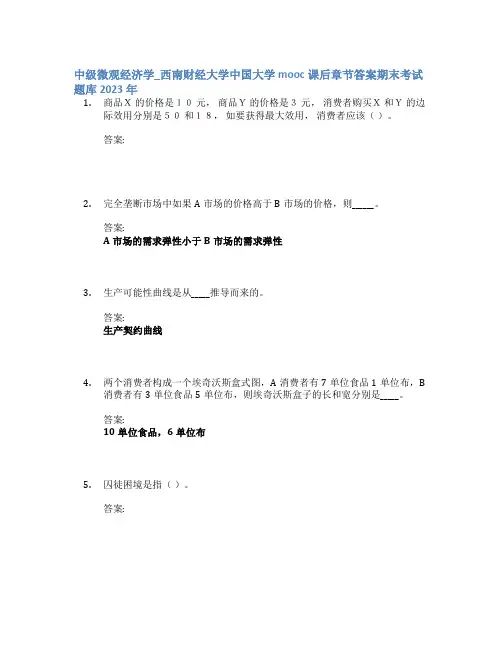
中级微观经济学_西南财经大学中国大学mooc课后章节答案期末考试题库2023年1.商品X的价格是10元,商品Y的价格是3元,消费者购买X和Y的边际效用分别是50和18,如要获得最大效用,消费者应该()。
答案:2.完全垄断市场中如果A市场的价格高于B市场的价格,则______。
答案:A市场的需求弹性小于B市场的需求弹性3.生产可能性曲线是从_____推导而来的。
答案:生产契约曲线4.两个消费者构成一个埃奇沃斯盒式图,A消费者有7单位食品1单位布,B消费者有3单位食品5单位布,则埃奇沃斯盒子的长和宽分别是_____。
答案:10单位食品,6单位布5.囚徒困境是指()。
答案:6.下列哪种情况属于帕累托改进? ()答案:7.下列市场结构中,经济效率最低的是()。
答案:8.如果需求曲线上一点,需求价格弹性的绝对值是2,价格P=30元,则MR是()。
答案:9.成本不变行业,完全竞争市场的长期供给曲线是()。
答案:10.设生产函数为q=min(3L,K),w和r为L和K的价格,该产品的扩展线是()。
答案:11.如果生产10单位产品的总成本是100元,第11单位的边际成本是21元,那么()。
答案:12.()偏好的替代效应为零。
答案:13.下列描述占优策略均衡和纳什均衡的关系是正确:()答案:占优策略均衡一定是纳什均衡14.若需求函数为Q=10-2P,在P=1处,需求价格弹性(绝对值)是()。
答案:15.薄利多销适合需求价格弹性()的商品。
答案:16.微观经济学解释的核心命题是()。
答案:17.斜率为正的供给曲线,离原点越远,其供给价格弹性()。
答案:18.对于普通物品,在其它条件不变时,商品价格下降,为什么需求量会增加?()答案:既存在替代效应,也存在收入效应19.完全竞争厂商的短期供给曲线是()。
答案:MC≥AVC的边际成本曲线20.完全竞争厂商生产产量Q=9,总成本为100,当生产产量增加到10时,平均成本为11,产品价格为15,该厂商()。
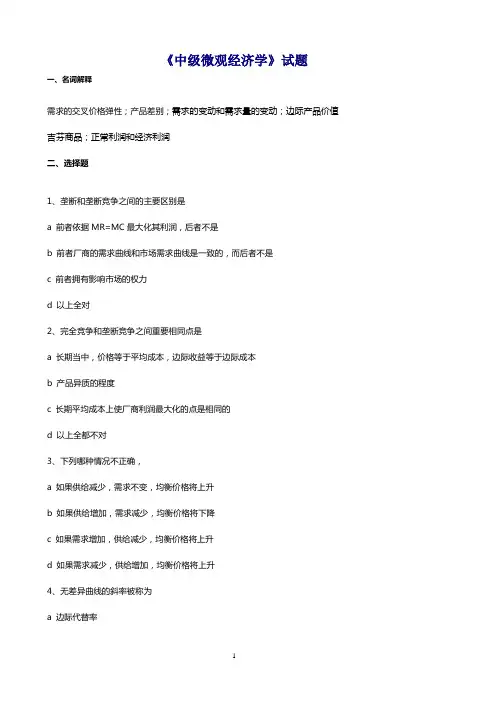
《中级微观经济学》试题一、名词解释需求的交叉价格弹性;产品差别;需求的变动和需求量的变动;边际产品价值吉芬商品;正常利润和经济利润二、选择题1、垄断和垄断竞争之间的主要区别是a 前者依据MR=MC最大化其利润,后者不是b 前者厂商的需求曲线和市场需求曲线是一致的,而后者不是c 前者拥有影响市场的权力d 以上全对2、完全竞争和垄断竞争之间重要相同点是a 长期当中,价格等于平均成本,边际收益等于边际成本b 产品异质的程度c 长期平均成本上使厂商利润最大化的点是相同的d 以上全都不对3、下列哪种情况不正确,a 如果供给减少,需求不变,均衡价格将上升b 如果供给增加,需求减少,均衡价格将下降c 如果需求增加,供给减少,均衡价格将上升d 如果需求减少,供给增加,均衡价格将上升4、无差异曲线的斜率被称为a 边际代替率b 边际技术代替率c 边际转换率d 边际效用5 、对于一个竞争性厂商而言,应使a P=ACb P=MR=ACc P=AR=MCd P=AR=MR6、正常利润是a 经济利润的一部分b 经济成本的一部分c 隐含成本的一部分d b和c两者6. 如果甲商品价格上升引起乙商品的需求曲线向左下方移动,那么a 甲和乙是替代品b 甲和乙是互补品c 甲是正常品,乙上次等品d 甲是次等品,乙是正常品7. 等产量线的斜率被称为a 边际代替率b 边际技术替代率c 边际转换率d 边际产品8. 一个完全竞争厂商发生亏损时,所在行业趋于长期均衡过程中可能发生的情况时a 较高的价格和较少的厂商b 较低的价格和较少的厂商c 较高的价格和较多的厂商d 较低的价格和较多的厂商三、是非题1.如果偏好是传递的,那么商品越多越好。
2.偏好为凸性的消费者认为两组合(1,4)和(9,2)并无差异。
那她至少不会更不喜欢(5,3)。
3.小马的效用函数是max{x,y},他的偏好是凸的。
4.如果两商品是替代品,那么其中一商品涨价会引起另一商品的需求下降。
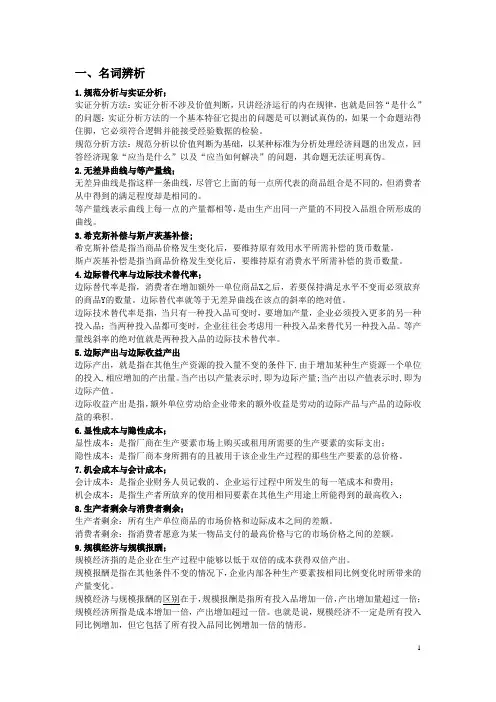
一、名词辨析1.规范分析与实证分析;实证分析方法:实证分析不涉及价值判断,只讲经济运行的内在规律,也就是回答“是什么”的问题;实证分析方法的一个基本特征它提出的问题是可以测试真伪的,如果一个命题站得住脚,它必须符合逻辑并能接受经验数据的检验。
规范分析方法:规范分析以价值判断为基础,以某种标准为分析处理经济问题的出发点,回答经济现象“应当是什么”以及“应当如何解决”的问题,其命题无法证明真伪。
2.无差异曲线与等产量线;无差异曲线是指这样一条曲线,尽管它上面的每一点所代表的商品组合是不同的,但消费者从中得到的满足程度却是相同的。
等产量线表示曲线上每一点的产量都相等,是由生产出同一产量的不同投入品组合所形成的曲线。
3.希克斯补偿与斯卢茨基补偿;希克斯补偿是指当商品价格发生变化后,要维持原有效用水平所需补偿的货币数量。
斯卢茨基补偿是指当商品价格发生变化后,要维持原有消费水平所需补偿的货币数量。
4.边际替代率与边际技术替代率;边际替代率是指,消费者在增加额外一单位商品X之后,若要保持满足水平不变而必须放弃的商品Y的数量。
边际替代率就等于无差异曲线在该点的斜率的绝对值。
边际技术替代率是指,当只有一种投入品可变时,要增加产量,企业必须投入更多的另一种投入品;当两种投入品都可变时,企业往往会考虑用一种投入品来替代另一种投入品。
等产量线斜率的绝对值就是两种投入品的边际技术替代率。
5.边际产出与边际收益产出边际产出,就是指在其他生产资源的投入量不变的条件下,由于增加某种生产资源一个单位的投入,相应增加的产出量。
当产出以产量表示时,即为边际产量;当产出以产值表示时,即为边际产值。
边际收益产出是指,额外单位劳动给企业带来的额外收益是劳动的边际产品与产品的边际收益的乘积。
6.显性成本与隐性成本;显性成本:是指厂商在生产要素市场上购买或租用所需要的生产要素的实际支出;隐性成本:是指厂商本身所拥有的且被用于该企业生产过程的那些生产要素的总价格。
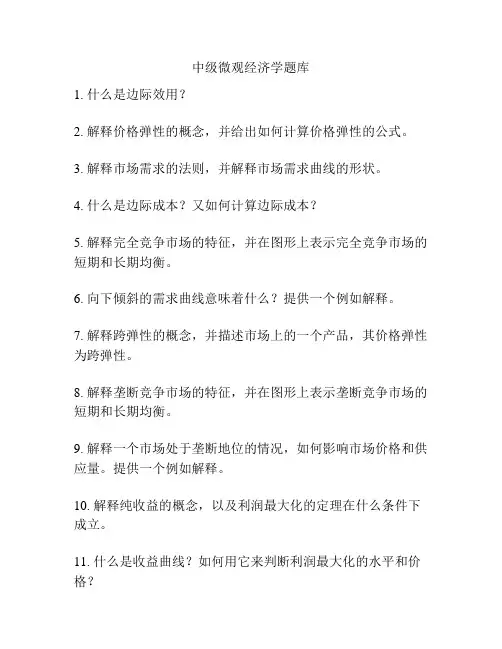
中级微观经济学题库
1. 什么是边际效用?
2. 解释价格弹性的概念,并给出如何计算价格弹性的公式。
3. 解释市场需求的法则,并解释市场需求曲线的形状。
4. 什么是边际成本?又如何计算边际成本?
5. 解释完全竞争市场的特征,并在图形上表示完全竞争市场的短期和长期均衡。
6. 向下倾斜的需求曲线意味着什么?提供一个例如解释。
7. 解释跨弹性的概念,并描述市场上的一个产品,其价格弹性为跨弹性。
8. 解释垄断竞争市场的特征,并在图形上表示垄断竞争市场的短期和长期均衡。
9. 解释一个市场处于垄断地位的情况,如何影响市场价格和供应量。
提供一个例如解释。
10. 解释纯收益的概念,以及利润最大化的定理在什么条件下成立。
11. 什么是收益曲线?如何用它来判断利润最大化的水平和价格?
12. 解释如何用边际分析来确定最优的生产决策,以及如何确定最优产出水平。
13. 解释生产函数的概念,并解释如何计算其边际产出。
14. 什么是价格歧视?提供一个例子,并解释大规模价格歧视和第一、第二价格歧视的概念。
15. 解释长期供应曲线的概念,以及它如何受到技术进步、资源价格和生产成本等因素的影响。
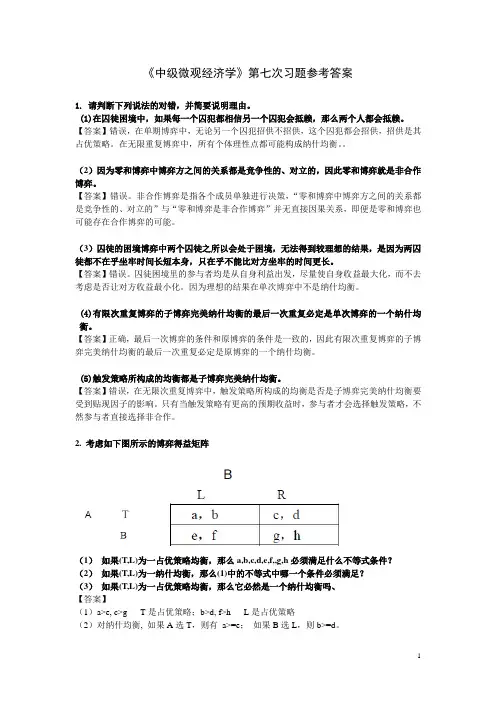
《中级微观经济学》第七次习题参考答案1. 请判断下列说法的对错,并简要说明理由。
(1)在囚徒困境中,如果每一个囚犯都相信另一个囚犯会抵赖,那么两个人都会抵赖。
【答案】错误,在单期博弈中,无论另一个囚犯招供不招供,这个囚犯都会招供,招供是其占优策略。
在无限重复博弈中,所有个体理性点都可能构成纳什均衡。
(2)因为零和博弈中博弈方之间的关系都是竞争性的、对立的,因此零和博弈就是非合作博弈。
【答案】错误。
非合作博弈是指各个成员单独进行决策,“零和博弈中博弈方之间的关系都是竞争性的、对立的”与“零和博弈是非合作博弈”并无直接因果关系,即便是零和博弈也可能存在合作博弈的可能。
(3)囚徒的困境博弈中两个囚徒之所以会处于困境,无法得到较理想的结果,是因为两囚徒都不在乎坐牢时间长短本身,只在乎不能比对方坐牢的时间更长。
【答案】错误。
囚徒困境里的参与者均是从自身利益出发,尽量使自身收益最大化,而不去考虑是否让对方收益最小化。
因为理想的结果在单次博弈中不是纳什均衡。
(4)有限次重复博弈的子博弈完美纳什均衡的最后一次重复必定是单次博弈的一个纳什均衡。
【答案】正确,最后一次博弈的条件和原博弈的条件是一致的,因此有限次重复博弈的子博弈完美纳什均衡的最后一次重复必定是原博弈的一个纳什均衡。
(5)触发策略所构成的均衡都是子博弈完美纳什均衡。
【答案】错误,在无限次重复博弈中,触发策略所构成的均衡是否是子博弈完美纳什均衡要受到贴现因子的影响。
只有当触发策略有更高的预期收益时,参与者才会选择触发策略,不然参与者直接选择非合作。
2. 考虑如下图所示的博弈得益矩阵(1)如果(T,L)为一占优策略均衡,那么a,b,c,d,e,f,,g,h必须满足什么不等式条件?(2)如果(T,L)为一纳什均衡,那么(1)中的不等式中哪一个条件必须满足?(3)如果(T,L)为一占优策略均衡,那么它必然是一个纳什均衡吗、【答案】(1)a>e, c>g T是占优策略;b>d, f>h L是占优策略(2)对纳什均衡, 如果A选T,则有a>=e;如果B选L,则b>=d。
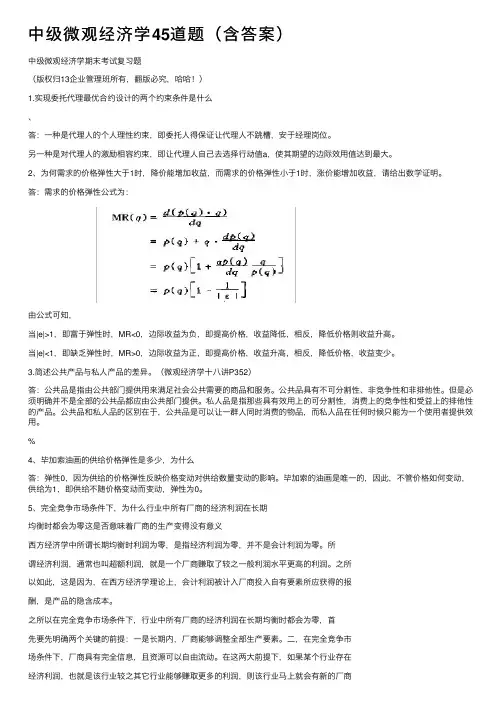
中级微观经济学45道题(含答案)中级微观经济学期末考试复习题(版权归13企业管理班所有,翻版必究,哈哈!)1.实现委托代理最优合约设计的两个约束条件是什么、答:⼀种是代理⼈的个⼈理性约束,即委托⼈得保证让代理⼈不跳槽,安于经理岗位。
另⼀种是对代理⼈的激励相容约束,即让代理⼈⾃⼰去选择⾏动值a,使其期望的边际效⽤值达到最⼤。
2、为何需求的价格弹性⼤于1时,降价能增加收益,⽽需求的价格弹性⼩于1时,涨价能增加收益,请给出数学证明。
答:需求的价格弹性公式为:由公式可知,当|e|>1,即富于弹性时,MR<0,边际收益为负,即提⾼价格,收益降低,相反,降低价格则收益升⾼。
当|e|<1,即缺乏弹性时,MR>0,边际收益为正,即提⾼价格,收益升⾼,相反,降低价格,收益变少。
3.简述公共产品与私⼈产品的差异。
(微观经济学⼗⼋讲P352)答:公共品是指由公共部门提供⽤来满⾜社会公共需要的商品和服务。
公共品具有不可分割性、⾮竞争性和⾮排他性。
但是必须明确并不是全部的公共品都应由公共部门提供。
私⼈品是指那些具有效⽤上的可分割性,消费上的竞争性和受益上的排他性的产品。
公共品和私⼈品的区别在于,公共品是可以让⼀群⼈同时消费的物品,⽽私⼈品在任何时候只能为⼀个使⽤者提供效⽤。
%4、毕加索油画的供给价格弹性是多少,为什么答:弹性0,因为供给的价格弹性反映价格变动对供给数量变动的影响。
毕加索的油画是唯⼀的,因此,不管价格如何变动,供给为1,即供给不随价格变动⽽变动,弹性为0。
5、完全竞争市场条件下,为什么⾏业中所有⼚商的经济利润在长期均衡时都会为零这是否意味着⼚商的⽣产变得没有意义西⽅经济学中所谓长期均衡时利润为零,是指经济利润为零,并不是会计利润为零。
所谓经济利润,通常也叫超额利润,就是⼀个⼚商赚取了较之⼀般利润⽔平更⾼的利润。
之所以如此,这是因为,在西⽅经济学理论上,会计利润被计⼊⼚商投⼊⾃有要素所应获得的报酬,是产品的隐含成本。
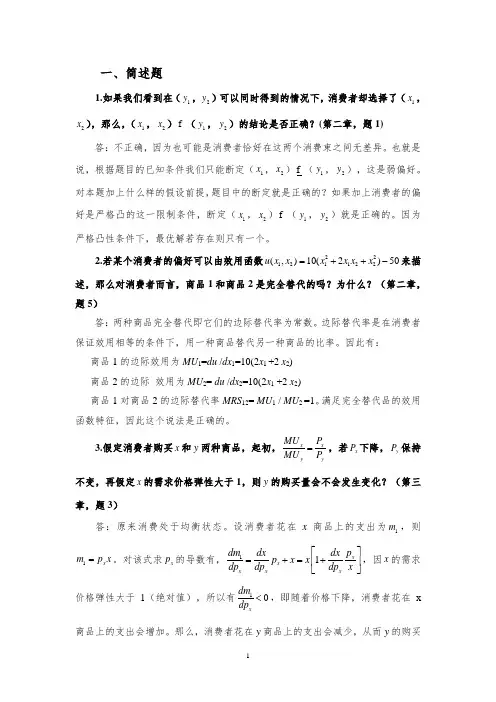
一、简述题1.如果我们看到在(1y ,2y )可以同时得到的情况下,消费者却选择了(1x ,2x ),那么,(1x ,2x ) (1y ,2y )的结论是否正确?(第二章,题1) 答:不正确,因为也可能是消费者恰好在这两个消费束之间无差异。
也就是说,根据题目的已知条件我们只能断定(1x ,2x ) (1y ,2y ),这是弱偏好。
对本题加上什么样的假设前提,题目中的断定就是正确的?如果加上消费者的偏好是严格凸的这一限制条件,断定(1x ,2x ) (1y ,2y )就是正确的。
因为严格凸性条件下,最优解若存在则只有一个。
2.若某个消费者的偏好可以由效用函数22121122(,)10(2)50u x x x x x x =++-来描述,那么对消费者而言,商品1和商品2是完全替代的吗?为什么?(第二章,题5)答:两种商品完全替代即它们的边际替代率为常数。
边际替代率是在消费者保证效用相等的条件下,用一种商品替代另一种商品的比率。
因此有: 商品1的边际效用为MU 1=du /dx 1=10(2x 1 +2 x 2)商品2的边际 效用为MU 2= du /dx 2=10(2x 1 +2 x 2)商品1对商品2的边际替代率MRS 12= MU 1 / MU 2 =1。
满足完全替代品的效用函数特征,因此这个说法是正确的。
3.假定消费者购买x 和y 两种商品,起初,x x y yMU P MU P =,若x P 下降,y P 保持不变,再假定x 的需求价格弹性大于1,则y 的购买量会不会发生变化?(第三章,题3)答:原来消费处于均衡状态。
设消费者花在x 商品上的支出为1m ,则1x m p x =。
对该式求x p 的导数有,11x x x x x p dm dx dx p x x dp dp dp x ⎡⎤=+=+⎢⎥⎣⎦,因x 的需求价格弹性大于1(绝对值),所以有10x dm dp <,即随着价格下降,消费者花在x 商品上的支出会增加。
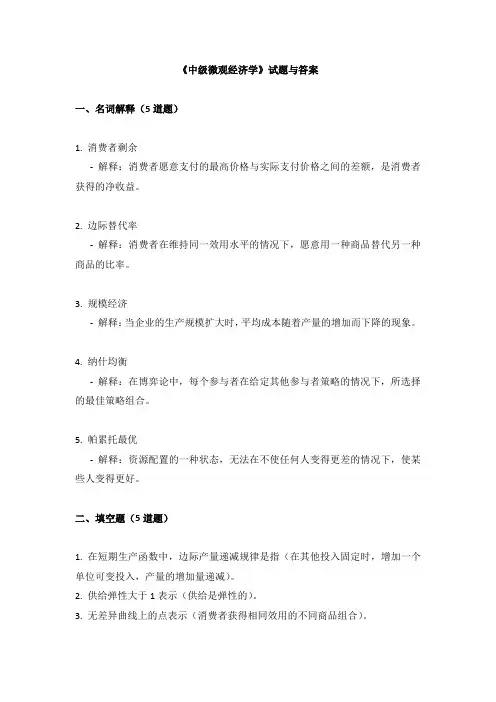
《中级微观经济学》试题与答案一、名词解释(5道题)1. 消费者剩余-解释:消费者愿意支付的最高价格与实际支付价格之间的差额,是消费者获得的净收益。
2. 边际替代率-解释:消费者在维持同一效用水平的情况下,愿意用一种商品替代另一种商品的比率。
3. 规模经济-解释:当企业的生产规模扩大时,平均成本随着产量的增加而下降的现象。
4. 纳什均衡-解释:在博弈论中,每个参与者在给定其他参与者策略的情况下,所选择的最佳策略组合。
5. 帕累托最优-解释:资源配置的一种状态,无法在不使任何人变得更差的情况下,使某些人变得更好。
二、填空题(5道题)1. 在短期生产函数中,边际产量递减规律是指(在其他投入固定时,增加一个单位可变投入,产量的增加量递减)。
2. 供给弹性大于1表示(供给是弹性的)。
3. 无差异曲线上的点表示(消费者获得相同效用的不同商品组合)。
4. 在完全竞争市场中,长期均衡时,企业的经济利润是(零)。
5. 价格上限政策可能导致的直接结果是(商品短缺)。
三、单项选择题(5道题)1. 下列哪一项不是完全竞争市场的特征?()。
- A. 大量的买者和卖者- B. 同质产品- C. 自由进入和退出市场- D. 厂商具有定价权-答案:D2. 在长期,完全竞争市场中的企业会选择生产在()。
- A. 平均成本最低的产量- B. 边际成本最低的产量- C. 平均总成本等于价格的产量- D. 边际成本等于价格的产量-答案:D3. 如果一种商品的需求是价格无弹性的,那么价格上升10%将导致需求量()。
- A. 增加10%- B. 减少10%- C. 减少少于10%- D. 减少多于10%-答案:C4. 在垄断市场中,垄断者的利润最大化产量是()。
- A. 边际成本等于价格- B. 边际收益等于价格- C. 边际收益等于边际成本- D. 平均成本等于边际成本-答案:C5. 在短期内,完全竞争企业的供给曲线是()。
- A. 平均总成本曲线- B. 平均可变成本曲线- C. 边际成本曲线- D. 边际成本曲线位于平均可变成本曲线之上的部分-答案:D四、多项选择题(5道题)1. 影响需求的主要因素有()。
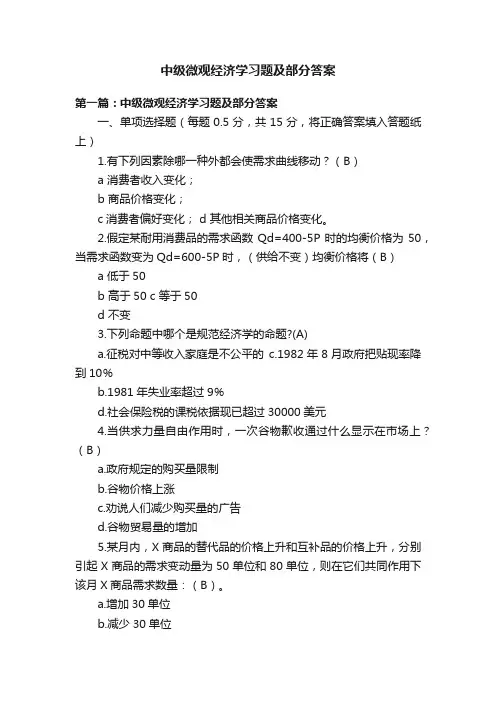
中级微观经济学习题及部分答案第一篇:中级微观经济学习题及部分答案一、单项选择题(每题0.5分,共15分,将正确答案填入答题纸上)1.有下列因素除哪一种外都会使需求曲线移动?(B)a 消费者收入变化;b 商品价格变化;c消费者偏好变化; d 其他相关商品价格变化。
2.假定某耐用消费品的需求函数Qd=400-5P时的均衡价格为50,当需求函数变为Qd=600-5P时,(供给不变)均衡价格将(B)a 低于50b 高于50c 等于50d 不变3.下列命题中哪个是规范经济学的命题?(A)a.征税对中等收入家庭是不公平的c.1982年8月政府把贴现率降到10%b.1981年失业率超过9%d.社会保险税的课税依据现已超过30000美元4.当供求力量自由作用时,一次谷物歉收通过什么显示在市场上?(B)a.政府规定的购买量限制b.谷物价格上涨c.劝说人们减少购买量的广告d.谷物贸易量的增加5.某月内,X商品的替代品的价格上升和互补品的价格上升,分别引起X商品的需求变动量为50单位和80单位,则在它们共同作用下该月X商品需求数量:(B)。
a.增加30单位b.减少30单位c.增加130单位d.减少130单位6.在完全竞争市场中,(C)。
a.消费者是价格接受者,而企业不是b.消费者和企业都不是价格接受者c.消费者和企业都是价格接受者d.企业是价格接受者,而消费者不是C曲线(A)。
a.当LMC<LAC时下降,而当LMC>LAC时上升b.随LMC曲线下降而下降c.随LMC曲线上升而上升d.通过LMC曲线的最低点8.一个企业在以下哪种情况下应该关闭?(A)a.P<AVCb.P<SACc.发生亏损时d.SMC>MR 9.寡头垄断和垄断竞争之间的主要区别是(C)。
a.厂商的广告开支不同b.非价格竞争的种类不同c.厂商之间相互影响的程度不同d.以上都不对10.短期内,完全竞争厂商只能通过对(D)调整来实现最大利润。
a.生产规模b.价格c.全部生产要素d.产量11.不完全竞争市场中出现低效率的资源配置是因为产品价格(A)边际成本a.大于b.小于等于d.大于或等于12.当市场处于长期均衡状态时,向右下方倾斜的需求曲线相切于长期平均成本的最低点的左边,产品的价格等于生产的平均成本,产品产量较高但存在多余的生产能力,则该市场属于下列哪一类(B)。
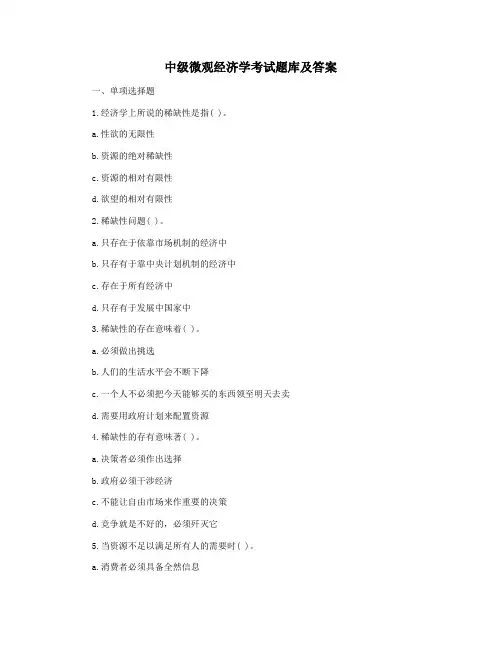
中级微观经济学考试题库及答案一、单项选择题1.经济学上所说的稀缺性是指( )。
a.性欲的无限性b.资源的绝对稀缺性c.资源的相对有限性d.欲望的相对有限性2.稀缺性问题( )。
a.只存在于依靠市场机制的经济中b.只存有于靠中央计划机制的经济中c.存在于所有经济中d.只存有于发展中国家中3.稀缺性的存在意味着( )。
a.必须做出挑选b.人们的生活水平会不断下降c.一个人不必须把今天能够买的东西领至明天去卖d.需要用政府计划来配置资源4.稀缺性的存有意味著( )。
a.决策者必须作出选择b.政府必须干涉经济c.不能让自由市场来作重要的决策d.竞争就是不好的,必须歼灭它5.当资源不足以满足所有人的需要时( )。
a.消费者必须具备全然信息b.政府必须决定谁的要求能被满足c.必须有一套市场系统起至促进作用d.必须作出选择6.当资源非常有限而性欲无穷时,人们必须( )。
a.作出选择b.减少他们的希望c.使公共利益优先于个人利益d.自给自足7.选择具有重要性,基本上是因为( )。
a.人们就是欲求的,他们的犯罪行为就是为了个人私欲b.相对于人类社会的无穷欲望而言,所需要的资源总是不足的c.一个经济必须依靠市场去化解稀缺性的问题d.政府对市场的影响有限8.因为资源就是匮乏的,所以( )。
a.必须作出选择b.政府必须分配资源c.某些人必须忍受贫穷d.除了富人之外所有人都必须做出挑选9.由政府来解决生产什么、如何生产和为谁生产这三个经济学基本问题的经济制度属于( )。
a.混合经济b.计划经济c.市场经济d.有计划的商品经济10.做为经济学的一个分支,微观经济学主要研究( )。
a.国际贸易b.不发达国家的经济快速增长c.通货膨胀和失业d.家庭和企业的经济犯罪行为二、判断题1.如果社会不存有资源的稀缺性,也就不能产生经济学。
( )2.只要有人类社会,就会存在稀缺性。
( )3.资源的稀缺性同意了资源可以获得充分利用,不能发生资源浪费现象。
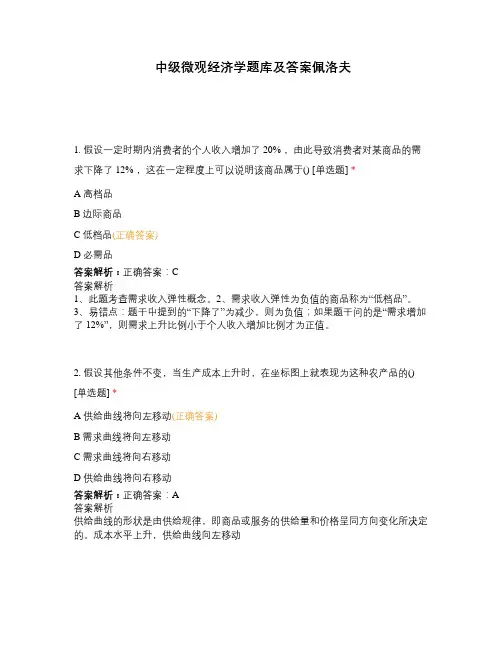
中级微观经济学题库及答案佩洛夫1. 假设一定时期内消费者的个人收入增加了20% ,由此导致消费者对某商品的需求下降了12% ,这在一定程度上可以说明该商品属于() [单选题] *A 高档品B 边际商品C 低档品(正确答案)D 必需品答案解析:正确答案:C答案解析1、此题考查需求收入弹性概念。
2、需求收入弹性为负值的商品称为“低档品”。
3、易错点:题干中提到的“下降了”为减少,则为负值;如果题干问的是“需求增加了12%”,则需求上升比例小于个人收入增加比例才为正值。
2. 假设其他条件不变,当生产成本上升时,在坐标图上就表现为这种农产品的() [单选题] *A 供给曲线将向左移动(正确答案)B 需求曲线将向左移动C 需求曲线将向右移动D 供给曲线将向右移动答案解析:正确答案:A答案解析供给曲线的形状是由供给规律,即商品或服务的供给量和价格呈同方向变化所决定的。
成本水平上升,供给曲线向左移动3. 甲商品和乙商品的价格按相同比例上升,而收入不变,则预算线的变化是()[单选题] *A 不变B 发生旋转C 向右上方平行移动D 向左下方平行移动(正确答案)答案解析:正确答案:D答案解析本题考查相对价格变动对预算线的影响。
两种商品的价格同比例同方向变动,并不会改变预算线的斜率,只会导致预算线发生平移。
如果价格同比例上升,表示消费者的全部收入用来购买其中任何一种商品的数量减少,预算线向左下方平行移动。
同理,如果价格同比例下降,预算线向右上方平行移动4. 不论在何种市场上,企业实现利润最大化的决策原则都是()。
[单选题] *A 边际收益等于边际成本(正确答案)B 边际收益大于边际成本C 价格大于平均成本D 劳动的边际产量为零答案解析:正确答案:A答案解析本题考查实现利润最大化的决策原则。
企业实现利润最大化的决策原则是:边际成本=边际收益。
5. 关于需求价格弹性和生产者或者销售者总销售收入关系的说法,正确的是()[单选题] *A在需求弹性系数大于1时,价格下降会使销售收入增加(正确答案)B在需求弹性系数等于1时,价格下降会使销售收入增加C在需求弹性系数等于1时,价格下降会使销售收入减少D在需求弹性系数小于1时,价格下降会使销售收入增加答案解析:正确答案:A答案解析本题考查需求价格弹性和总销售收入的关系。
中级微观经济学题库第一章市场1.1 假定市场中最初有5单位公寓,而其中的一个单位变成了公共品。
(a)假设需求者A决定买下该公共物品。
使得公寓的需求等于供给的最高价格是多少?最低价格是多少?在表中的A列中填入你的答案。
然后计算一下,如果B,C,…决定购买该公共品时公寓的均衡价格。
(b)假设在每个保留价格下有两个需求者,共有10套公寓。
供给等于需求的最高价格是多少?假设这些公寓中的一套变成了公共品,这一最高价格还是均衡价格吗?需求者 A B C D E F G H最高价最低价1.2 现在假定有一个垄断者拥有所有的公寓,他要决定能够最大化他的收入的价格和数量。
(a)如果该垄断者租出1,2,…,8套公寓,在下表中填写他能获得的最高价格和收入。
(假定他必须对所有的公寓索要同样的价格。
)(b)从A到F中,哪些人租到了公寓?(c)如果法律要求垄断者刚好租出5套公寓,为了最大化收入,他索要的价格将是多少?(d)哪些人会租到公寓?(e)假定该房东可以向每个人索要不同的价格,并且他知道每个人的保留价格。
如果他将5套公寓全部租出,他能获得的最大收入是多少?(f)如果5套公寓都租出去了,哪些人租到了公寓?数量 1 2 3 4 5 6 7 8价格收入第二章预算约束2.1 在波罗的海附近的一个小国中,只有三种商品:土豆、肉丸和果酱。
在过去的近50年里,价格都十分稳定。
土豆每袋2克朗,肉丸每坛4克朗,果酱每罐6克朗。
(a)一个叫Gunnar的公民,他每年有360克朗的收入,写出他的预算方程。
令P、M、J分别代表Gunnar在一年中所消费的土豆的袋数、肉丸的坛数和果酱的罐数。
(b)该国的公民一般都十分聪明,但是他们不擅长乘以2的计算。
这使得购买土豆成为了一件令许多公民痛苦的困难事情。
因此该国决定引入一种新的货币单位,使得土豆成为计价物。
一代土豆要花费一单位的新货币,但相对价格与过去一样。
用新货币表示的肉丸价格是多少?(c)用新货币表示的果酱价格是多少?(d)要使Gunnar能够买得起变革之前他所消费的相同的商品束,他以新货币表示的收入必须是多少?(e)写出Gunnar的新预算方程。
一、单选题(在每小题的四个备选答案中选择一个正确的答案代码填入下列表格中的相应题号下,每小题2分,共30分)题号 1 2 3 4 5 答案 题号 6 7 8 9 10 答案 题号 11 12 13 14 15 答案1、如果某种商品的市场需求曲线向右下方倾斜,供给曲线水平,对该种商品征收从量税。
下列说法中哪一个是正确的 。
A. 最终由供给者承担所有税收负担;B. 最终由需求者承担所有税收负担;C. 供给价格上升;D. 需求价格下降2、已知边际成本函数为()2MC y y =+,则在产量y =10时总可变成本等于 。
A. 40;B. 50;C. 60;D. 703、一个竞争性厂商在短期利润最大化的产量水平处一定有 。
云南财经大学 2012 至 2013 学年 第一 学期《中级微观经济学》 课程期末考试试卷(A 试)浅蓝辅导 财大辅导第一品牌专业辅导 微积分 概率论 统计学 计量经济学联系方式:陈同学学号: 姓名: 班级: 专业: 院(系): 答 案 不 得 超 过 装 订 线A. 产品价格等于边际成本;B. 产品价格等于平均可变成本;C. 产品价格等于平均成本;D. 产品价格高于边际收益 4、短期当中 。
A. 只存在可变要素;B. 只存在不变要素;C. 只存在可变成本;D. 存在可变成本和固定成本5、长期内,一家生产技术规模报酬不变的企业所能获得的最高利润 。
A. 为零;B. 为正;C. 为负;D. 三者皆有可能6、当消费者对两种商品间的边际替代率为-2时,他为得到2单位的商品1而最多愿意支付 单位的商品2。
A. 1;B. 2;C. 4;D. 67、消费者偏好是“拟线性偏好”,效用函数为()v x y +。
则下列说法中哪一个是正确的 。
A. 边际替代率的大小与y 无关;B. 收入变动不会影响x 的需求量;C. 消费者将不会消费x ;D. 无差异曲线可能相交 8、已知“生产者剩余”变动10单位,则“利润”变动 。
中级微观经济学模拟试题7I True or false(2points*10).1.Since a monopoly charges a price higher than marginal cost, it will produce aninefficient amount of output.2. A duopoly in which two identical firms are engaged in Bertrand competition willnot distort prices from their competitive levels.3.The change in producer's surplus when the market price changes from p1to p2ishalf of the area to the left of the marginal cost curve between p1and p2.4.If the production function is f(x1;x2) = min(x1 ,x2); then the cost function isc(w1;w2;y) =min(w1;w2;y )5. A monopolist with constant marginal costs faces a demand curve with a constantelasticity of demand and does not practice price discrimination. If the government imposes a tax of $1 per unit of goods sold by the monopolist, the monopolist will increase his price by more than $1 per unit.6.John purchases two goods, x and y. Good x is an inferior good for some range ofincome, there must be another range of income for which good x is a normal good.7.Ambrose’s utility function is U(x,y)=x+4y1/2. The price of x is 1 and the price of yis 2. If his income rises from 100 to 150, his consumption of y increases by more than 10% but less than 50%.8.Bill Katz prefers more of good 1 to less and he prefers less of good 2 to more. Billhas convex preferences. If we draw his indifference curves with good 1 on the horizontal axis and good 2 on the vertical axis, then his indifference curves have positive slope but get steeper as they rise.9.In a competitive pure exchange economy, if the total value of excess demand forall types of food is zero, then the total value of excess demand for all nonfood commodities must be zero.10.In Nash equilibrium, each player is making an optimal choice for herself, giventhe choices of the other players.II Fill in the blanks for the following questions(2points*10): (1)Professor Stern's colleague, Dr. Schmertz, gives one midterm exam and a Finalexam. He weights the final twice as heavily as the midterm to determine the course grade. No grades can be dropped. If the midterm score is represented on the horizontal axis and the final score on the vertical axis, and if a student in Dr.Schmertz's class cares only about her course grade, her indifference curve is a line with slope ___________.(2)Casper's utility function is y3; where x is his consumption of cocoa and y isx+his consumption of cheese. If the total cost of x units of cocoa is 2x; if the price of cheese is 10, and Casper's income is $260, how many units of cocoa will he consume?____________(3)Brand X is one of many firms in a competitive industry where each firm has aconstant marginal cost of 2 dollars per unit of output. If marginal cost for Brand X rises to 4 dollars per unit and marginal costs of all other firms in the industry stay constant, by how much does the price in the industry increase?____________________(4)An industry has two _rms. The inverse demand function for this industryis q=. Both firms produce at a constant unit cost of $32 per unit. What is p292-the Cournot equilibrium price for this industry? _________________________ (5)One unit of zinc and one unit of copper are needed to produce a unit of brass. Theworld's supply of zinc and the world's supply of copper are owned by two different monopolists. For simplicity assume that it costs nothing to mine zinc and copper, that no other inputs are needed to produce brass and that the brass industry operates competitively. Then the price of a unit of brass equals the cost of the inputs used to make it. The demand function for brass is p =where p is900-q2 the price of brass. The zinc and copper monopolists each set a price, believing that the other monopolist will not change his price. What is the equilibrium price of brass? ___________________III. Calculation (25 points)1. For a typical Cobb-Douglas technology, use calculus to derive the cost function of the firm.(10 points)2. Smith is the owner of a sole mineral water spring in an isolated economy. It costs Smith $2 per gallon to get his waterbottled. The inverse demand curve for Smith’s water is p = 20 - q / 5 , where p is the price per gallon and q is the number of gallon sold.a. Write down an expression π(q ) for profits as a function o f q. Find theprofit-maximizing choice of q for Smith, and the corresponding price and profit.(10 points)b. Suppose now Henry, Smith’s neighbor, finds also a mineral spring that producesmineral water just as good as Smith’s, but it costs Henry $6 a bottle. The total market demand remains as before. Determine the Cournot duopoly equilibrium.(5 points)IV. Graphing and Analysis (35 points)1. Randy Ratpack hates studying both economics and history. The more time he spends studying either subject, the less happy he is. But Randy has strictly convex preferences.Draw the indifference curves corresponding to Randy’s preference. (10 points)2. Derive graphically the labor supply curve from the optimal choice of a consumer who has endowment of two commodities: labor and other goods. Note that both are desirable.(10 points)3. Assume individuals are choosing between housing services (H) measured in square feet and consumption of all other goods (C) in dollars. Suppose now the government agrees to subsidize consumers by paying 50% of their housing cost.a. Draw to show how will the budget line of a typical consumer change? Showalso her original choice and the new choice. (5 points)b. Show in the same diagram the minimum amount of income supplement the government would have to give the consumer instead of the housing subsidy to make them as well off as she was in Part a. (10 points)。
中级微观经济学练习题1、吴兵有一份每小时¥15的工作,如果他每周工作超过40小时,他将得到50%的超时奖金,即工资上升到¥22.5元/小时。
他只偏好单一商品消费和娱乐,而且他每周可以利用80小时(另外88小时用于睡觉和路途)。
假定单一商品的价格是¥6/单位。
请画出他的预算线。
2、某个消费者的效用函数为U(x1,x2)=x12x2。
令P1,P2与m分别表示商品1的价格、商品2的价格和收入。
(1)如果m=24, p1=1, p2=1 , 现在P1的价格上升为2,求此消费者关于商品1的斯勒茨基替代效应和收入效应。
(2)请根据计算,验证恩格尔加总规则。
3、消费者对(x1,x2)的效用函数是拟线性的效用函数U=x1+x21/2,x1的价格为1,x2的价格为p2,消费者的收入为m。
(1)求x1,x2的需求函数(2)收入变化是否影响对x1和x2的消费?(3)设m=100,p2从1变化到2,计算该消费者从消费x2商品获得的消费者剩余的变化?4、设消费者对(x1,x2)的效用函数是U=x1+x2,x1的价格为2,x2的价格为1。
消费者的收入是m=100.(1)计算当p1从2变为1/2时对x1的需求的变化。
(2)计算该变化的斯勒茨基替代效应和收入效应,并用图表示出来。
5、利用效用函数u(x1,x2)=x11/3x21/2,预算约束m=p1x1+p2x2。
计算X(p,m),γ(p,m),h(p,u)和e(p,u)6、假设一个人对面包(y)和可乐(x)的偏好可以用下列效用函数来表达,U(x1,x2)=x11/2x21/2。
初始状态下,p x=1/2, p y=2,m=4。
现在假设可乐的价格p x由1/2上升到2,计算由于p x变化引起的补偿性变化CV 、等值性变化EV 。
7、消费者的效用函数为u=(c 1,c 2)=c 10.4•c 20.6 。
在第一期和第二期的收入分别为100元和180元,利率为r 。
求:(1)第一期和第二期的消费分别为多少?(2)r 取什么值时,该消费者在第一期将储蓄、贷款或不借贷。
20081、交易的一般均衡答::交易的一般均衡,指当社会生产状况既定、收入分配状况既定条件下,通过要素所有者之间的交易使交易者达到效用最大化的均衡状况。
要达到交易的一般均衡,必须满足的条件是,任意两种商品x、y的边际替代率(MRSXY)对每一个参加交易的人来说都是相同的。
证明:E2点或E3点是A、B两消费者效用最大化的均衡点,具交易的一般均衡的条件是MRSXY A= MRSXYBUB(XB、YB)=U0XA+XB=WXY A+YB=WY目标函数UA(XA,YA) --- Max根据目标函数与约束条件,可得到拉格朗日函数L= UA(XA,YB) +λ〔UB(XB、YB) - U0〕- μ1(XA+XB - WX )- μ2(YA+YB - WY)分别对变量XA、XB、YA、YB 求一阶偏导数,并令偏导数值等于0,可得到以下四个一阶条件әL/әXA = әUA/әXA - μ1 = 0әL/әYA = әUA/әY A - μ2 = 0әL/әXB = -λ(әUB/әXB) - μ1 = 0әL/әYB = -λ(әUB/әYB) - μ2 = 0由上述四式整理可得әUA/әXA = μ1 (1)әUA/әYA = μ2 (2)-λ(әUB/әXB) = μ1 (3)-λ(әUB/әYB) = μ2 (4)用(1)式比(2)式,用(3)式比(4)式,得到由此可得到交易的一般均衡条件MRSAXY=MRSBXY3、规模经济答:规模经济和规模不经济用来说明厂商产量变动从而规模变动与成本之间的关系。
如果产量扩大1倍,而厂商的生产成本的增加低于1倍,则厂商的生产存在着规模经济;如果产量扩大1倍,而厂商的生产成本的增加大于1倍,则厂商的生产存在着规模不经济;用数学式表达:若厂商的成本函数为c=f(y),任意常数t>1,如果c(ty)<tc(y),处于规模经济阶段,如果c(ty)>tc(y),处于规模不经济阶段。
《中级微观经济学》习题第一章绪论1、英国古典经济学家大卫·李嘉图在《政治经济学及税赋原理》一书中认为,市场经济是商业完全自由的经济制度,如果没有外在干预的影响,它会自然地、有序地发展下去。
李嘉图指出:“在没有政府的干预时,农业、商业和制造业最为繁荣。
”国家需要做的全部事情,就是避免一切干预,既不要鼓励生产的一个源泉,也不要抑制另一个源泉。
对此观点,你有什么看法?请予以系统论述。
2、微观经济学研究极大满足人类需要的方式,但这真的是一个切合实际的目标吗?比如,假设人民需要不好的东西,如吸毒、酗酒等等.尽可能满足人们的这些需要仍是切合实际的吗?微观经济学对人们的需要的假设有什么问题?你认为应怎样改进?3、对大多数经济政策问题,人们可以发现经济学家之间存在很大的分歧,这能证明经济学不是一门科学吗?4、在评价经济学家的论述的准确性时,你是否能够区分:(1)经济学家的那些论述是描述性的?(2)那些是它们关于究竟应采取何种政策的论述。
5、西方有一种“奥卡姆剃刀”原则:如无必要,勿增实体。
如果两个模型预测的准确度相同,我们应选择不太复杂的那个?你是否赞成这种观点?你如何去判断一个模型的复杂程度?6、为什么一个不能通过经验事实来验证的理论不是一个好的理论?第二章供给和需求的基本原理1、需求的价格弹性有哪些类型?它们是怎样划分的?2、什么是价格控制?政府干预市场价格的后果是什么?3、短期弹性与长期弹性的区别?4、影响需求弹性与价格弹性的因素分别有哪些?5、假定需求函数为,其中M不是收入,P表示水平价格,N(N>0)为常数。
求:需求的价格点弹性和需求的收入点弹性。
6、若某商品市场是有100个消费者,其中,60个消费者购买该市场1/3的商品,且每个消费者的需求的价格弹性为3;另外40个消费者购买该市场2/3的商品,且每个消费者的需求的价格弹性为6。
求:按照100个消费者合计的需求的价格弹性是多少?7、画图说明蛛网模型的三种情况。
I True or false(2points*10).1.Since a monopoly charges a price higher than marginal cost, it will produce aninefficient amount of output.2. A duopoly in which two identical firms are engaged in Bertrand competition willnot distort prices from their competitive levels.3.The change in producer's surplus when the market price changes from p1to p2ishalf of the area to the left of the marginal cost curve between p1and p2.4.If the production function is f(x1;x2) = min(x1 ,x2); then the cost function isc(w1;w2;y) =min(w1;w2;y )5. A monopolist with constant marginal costs faces a demand curve with a constantelasticity of demand and does not practice price discrimination. If the government imposes a tax of $1 per unit of goods sold by the monopolist, the monopolist will increase his price by more than $1 per unit.6.John purchases two goods, x and y. Good x is an inferior good for some range ofincome, there must be another range of income for which good x is a normal good.7.Ambrose’s utility function is U(x,y)=x+4y1/2. The price of x is 1 and the price of yis 2. If his income rises from 100 to 150, his consumption of y increases by more than 10% but less than 50%.8.Bill Katz prefers more of good 1 to less and he prefers less of good 2 to more. Billhas convex preferences. If we draw his indifference curves with good 1 on the horizontal axis and good 2 on the vertical axis, then his indifference curves have positive slope but get steeper as they rise.9.In a competitive pure exchange economy, if the total value of excess demand forall types of food is zero, then the total value of excess demand for all nonfood commodities must be zero.10.In Nash equilibrium, each player is making an optimal choice for herself, giventhe choices of the other players.II Fill in the blanks for the following questions(2points*10): (1)Professor Stern's colleague, Dr. Schmertz, gives one midterm exam and a Finalexam. He weights the final twice as heavily as the midterm to determine the course grade. No grades can be dropped. If the midterm score is represented on the horizontal axis and the final score on the vertical axis, and if a student in Dr.Schmertz's class cares only about her course grade, her indifference curve is a line with slope ___________.(2)Casper's utility function is y3; where x is his consumption of cocoa and y isx+his consumption of cheese. If the total cost of x units of cocoa is 2x; if the price of cheese is 10, and Casper's income is $260, how many units of cocoa will he consume?____________(3)Brand X is one of many firms in a competitive industry where each firm has aconstant marginal cost of 2 dollars per unit of output. If marginal cost for Brand X rises to 4 dollars per unit and marginal costs of all other firms in the industry stay constant, by how much does the price in the industry increase?____________________(4)An industry has two _rms. The inverse demand function for this industryis q=. Both firms produce at a constant unit cost of $32 per unit. What is p292-the Cournot equilibrium price for this industry? _________________________ (5)One unit of zinc and one unit of copper are needed to produce a unit of brass. Theworld's supply of zinc and the world's supply of copper are owned by two different monopolists. For simplicity assume that it costs nothing to mine zinc and copper, that no other inputs are needed to produce brass and that the brass industry operates competitively. Then the price of a unit of brass equals the cost of the inputs used to make it. The demand function for brass is p=where p is900-q2 the price of brass. The zinc and copper monopolists each set a price, believing that the other monopolist will not change his price. What is the equilibrium price of brass? ___________________III. Calculation (25 points)1. For a typical Cobb-Douglas technology, use calculus to derive the cost function of the firm.(10 points)2. Smith is the owner of a sole mineral water spring in an isolated economy. It costs Smith $2 per gallon to get his water bottled. The inverse demand curve for Smith’s water is p = 20 - q / 5 , where p is the price per gallon and q is the number of gallon sold.a. Write down an expression π(q ) for profits as a function of q. Find theprofit-maximizing choice of q for Smith, and the corresponding price and profit.(10 points)b. Suppose now Henry, Smith’s neighbor, finds also a mineral spring that producesmineral water just as good as Smith’s, but it costs Henry $6 a bottle. The total market demand remains as before. Determine the Cournot duopoly equilibrium.(5 points)IV. Graphing and Analysis (35 points)1. Randy Ratpack hates studying both economics and history. The more time he spends studying either subject, the less happy he is. But Randy has strictly convex preferences.Draw the indifference curves corresponding to Randy’s preference. (10 points)2. Derive graphically the labor supply curve from the optimal choice of a consumer who has endowment of two commodities: labor and other goods. Note that both are desirable.(10 points)3. Assume individuals are choosing between housing services (H) measured in square feet and consumption of all other goods (C) in dollars. Suppose now the government agrees to subsidize consumers by paying 50% of their housing cost.a. Draw to show how will the budget line of a typical consumer change? Showalso her original choice and the new choice. (5 points)b. Show in the same diagram the minimum amount of income supplement the government would have to give the consumer instead of the housing subsidy to make them as well off as she was in Part a. (10 points)。